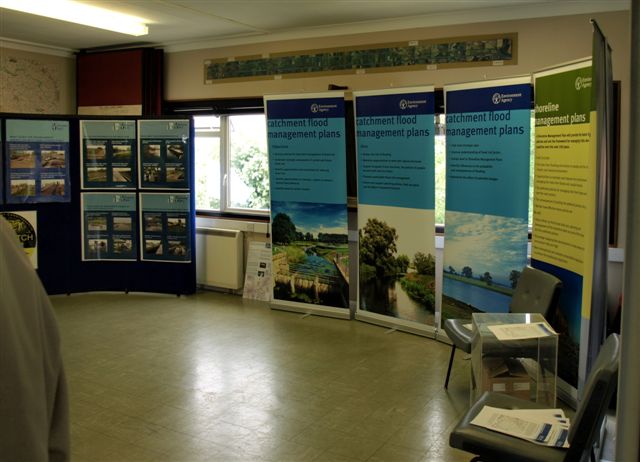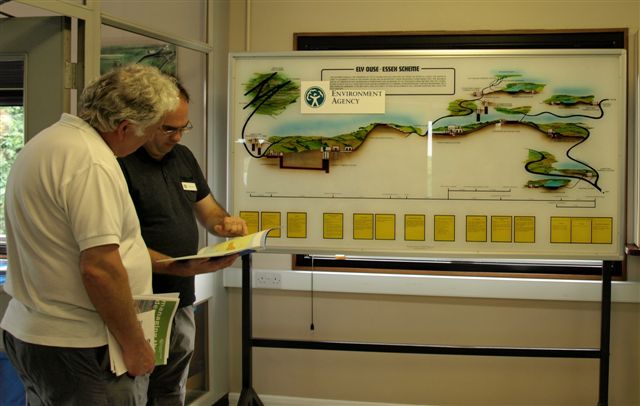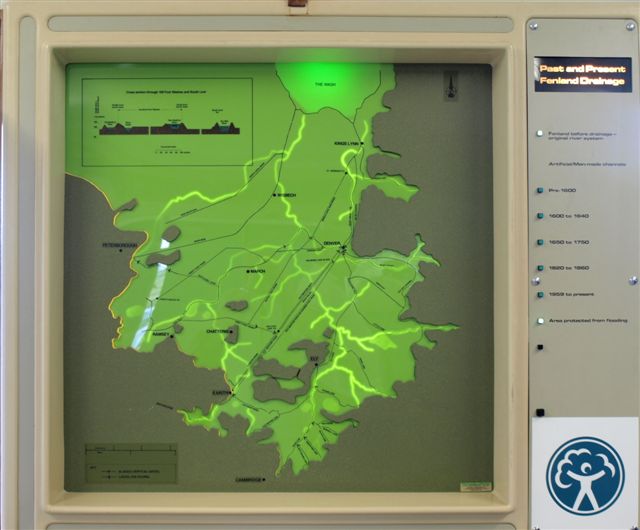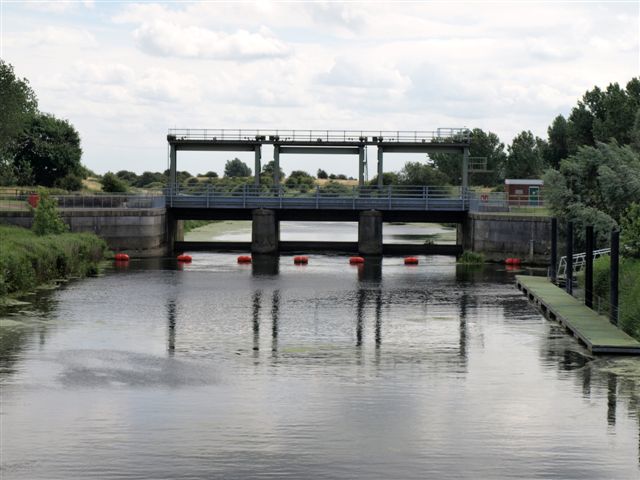- Main pages of this site
| Main pages of this website |
| Home page & index |
| Overview history & management |
| Features, Structures & site index |
| Contents of this page |
| Introduction |
Introduction
I had often driven along the road that crosses over the Denver Sluice and seen this sign on the fence outside the lock-keeper's office, but it wasn't until I attended the open-day on Wednesday 16th July 2008 that I had a chance to read it.
My reason for visiting was a general interest in the workings of the Ouse washes, but my "project" (see home page) had not yet started in earnest.
I went with a small party that included the webmasters of the Nordelph and Welney community websites and their wives. We first enjoyed a splendid lunch at the nearby Jennyns Arms, dining on the riverside terrace in warm sunshine. Luckily we had chosen the first of the two open days - the next was chilly, wet and miserable.
Exhibition Room
Our visit started here in a room at the top of the Complex control building.
There were lots of information boards and several members of staff to explain the workings. We discovered that Denver Sluice itself is actually just one of several sluices within the Denver Complex site.
There's the AG Wright Sluice (also known as the Head Sluice), The John Martin Sluice (commonly known as Welmore Lake Sluice), the Residual Flow Sluice, the Diversion Sluice and the Impounding Sluice. There was mention too of a Tail Sluice but I think that's somewhere else; it is, as they kept stressing, very complex.
Luckily there were various information leaflets and a map to take away for those of us who couldn't quite take it all in at the time.
One display (below) shows how surplus water can be pumped via pipelines and natural watercourse from Denver to Essex, the driest county in the UK with half the average national rainfall. Officially this is named 'The Ely Ouse to Essex Transfer Scheme' (EOETS), but more commonly known as the Abberton Scheme after the reservoir south of Colchester which receives most of the water. We also discovered that the operator of the Abberton Reservoir trades as Essex & Suffolk Water, but is actually Northumbrian Water.

The EA official here is explaining the operation in more detail to an intrigued visitor - the webmaster of the Nordelph Website.
Past and Present Fenland Drainage.

This interesting interactive electronic map enabled us to see the courses of the man-made rivers and drains at different periods in history, from pre 1600 to post 1959, by pressing an appropriate button.
We then donned yellow waistcoats and joined a guided tour party.
 We visited three (or was it four?) sluices and learned (and in my case soon forgot) their names. I
do remember the one above was part of Denver Sluice because of the silt island; the
one below was either the Diversion or Impounding Sluice. We were told how old they were, how much water passed through them, how the doors and gates worked, and how complicated it all was to operate them to satisfy the differing needs of very diverse "interest groups" - an expression which includes residents of Welney and those affected by flooding on the Wash Road.
We visited three (or was it four?) sluices and learned (and in my case soon forgot) their names. I
do remember the one above was part of Denver Sluice because of the silt island; the
one below was either the Diversion or Impounding Sluice. We were told how old they were, how much water passed through them, how the doors and gates worked, and how complicated it all was to operate them to satisfy the differing needs of very diverse "interest groups" - an expression which includes residents of Welney and those affected by flooding on the Wash Road.
Our guide, one of two operators living on site, did his best to make the tour interesting, but as nothing was happening at the time it was difficult for those who are not total sluice anoraks to pay full attention right to the end. We didn't see any buttons pushed, levers pulled, wheels turned, "V" doors opened or closed, or sluice gates raised or lowered. We didn't even see Julie Reinger from BBC TVs 'Look East' programme who presented her weather forecast from the site later in the day.
This is a view of Denver Sluice seen from the downstream side, taken 5 days after the open-day in July 2008.

The large gate on the right was a lock for large commercial craft but has been permanently closed for many years; the gate on the left is the navigation lock; the three arches between those gates house the huge timber 'V' doors, known as the "little eyes", which should open to allow water from the Ely Ouse to flow into the Tidal River.
However, they were so badly silted up in the 2006-7 winter that they could not be opened. Some people said this was one of the reasons why water stayed on the Ouse washes and on the Wash Road at Welney for so long before being evacuated out to sea via the Tidal River. I don't really understand that because floodwater from the washes water doesn't flow through this sluice. Maybe it's to do with silt raising the river bottom and slowing down the flow. If you know, please contact me.
The EA began to remove the silt from the doors and repair them in the autumn of 2007 and work was to have been completed by June 2008. However, on the day of our visit only one was operational, the other two still sealed off by temporary gates. I understand work on the others should now be finished in mid-August, and they should be fully operational in September.
I took this photo nearly a year earlier, in August 2007.
 It shows the huge island of silt on the downstream side of Denver Sluice. In the
2008 photo it looks as though the amount of silt is less - but it's difficult to be certain as the tide in this earlier photo is lower, so more silt would be exposed. The photos are also taken from different positions & angles and with different cameras, so direct comparison is not possible.
It shows the huge island of silt on the downstream side of Denver Sluice. In the
2008 photo it looks as though the amount of silt is less - but it's difficult to be certain as the tide in this earlier photo is lower, so more silt would be exposed. The photos are also taken from different positions & angles and with different cameras, so direct comparison is not possible.Back to July 2008. The temporary barrier gates known as stop-logs or damboards are still in place in front of two of the "V" doors

Various air and water jetting systems are being considered to keep the doors clear of silt in future, and trials may begin next year.
|
page last updated 09 December 2012 |
| If visted before, please "refresh" page to see latest version. |
|
Acknowledgements. Text and photos except where noted © Eddy Edwards, 2010-12 If you think there are any errors or omissions on this page or would like to comment, please e-mail me and your response will be noted where appropriate. |
| Related pages on this website |
| Denver Sluice - history & operation |
| Welmore Lake Sluice |
| Salter's Lode |
| Related pages on external websites |